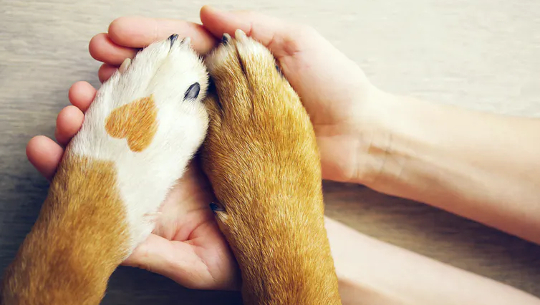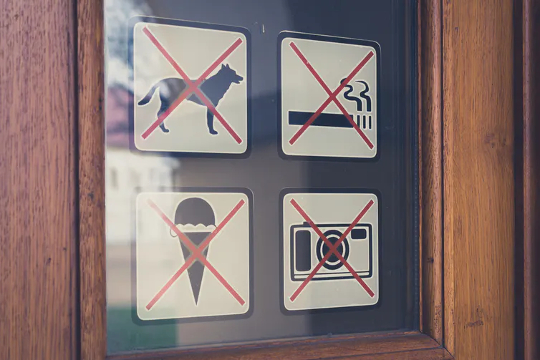
Pawsitively hygienic. savitskaya iryna/Shutterstock
Well over 10,000 people in Europe use an assistance dog; think of guide dogs for people with a visual impairment, hearing dogs for people with a hearing impairment, medical response service dogs and psychiatric service dogs.
According to article 19 and 20 of a UN agreement, these dogs are welcome in hospitals, shops and other public places. In practice, though, many users and their dogs are regularly refused entry. Often, hygiene is given as the main argument.
When we heard about another one of those examples from a military veteran with post-traumatic stress disorder and his assistance dog, we decided to find out how much truth there is in claims that it’s not hygienic to allow dogs into a hospital. Our pilot study together with master’s student Jasmijn Vos (Faculty of Veterinary Medicine, Utrecht University) shows that the paws of assistance dogs are cleaner than the shoe soles of their users, and so paw hygiene is no reason to ban assistance dogs from hospitals.

Dogs are often refused entry for hygiene reasons. hanohiki/Shutterstock
We swabbed the paws of 25 assistance dogs and the shoe soles of their users. The participants were instructed to walk their dog for 15 to 30 minutes before the samples were taken. For comparison, we also investigated an equally sized group of pet dogs and their owners. We wanted to see if the training the assistance dogs received would lead to cleaner paws.
We examined the samples for poop bacteria (Enterobacteriaceae family), which are very common in the outdoor environment, and for an important diarrhoeal bacteria (Clostridium difficile).
The reason we focused on these bacteria is because earlier studies show that other hazardous bacteria, such as methicillin-resistant Staphylococcus aureus (MRSA), vancomycin-resistant enterococci (VRE) and extended-spectrum beta-lactamase (ESBL) Escherichia coli are rarely found on dogs. We also didn’t focus on saliva because assistance dogs are well trained and don’t use their tongues to discover their surroundings, so saliva is not a big risk.
Our results, which are published in the International Journal of Environmental Research and Public Health, showed that all dog paws turned out to be cleaner than shoe soles. The paws were negative for Enterobacteriaceae more often than shoe soles, and when they were positive, they carried fewer bacteria of this family. This renders the hygiene argument, which is often used to ban assistance dogs from public locations, invalid.
Also, the diarrhoeal bacteria did not occur on any of the dogs’ paws – both assistance dogs and pet dogs – whatsoever, and only once on a shoe sole in the assistance dog users’ group.
As this is a pilot study, the number of participants was limited and a future, larger study might be able to find out if there are any factors that can be linked to the presence of Enterobacteriaceae bacteria on paws and shoe soles. This study could not find any, but a larger sample size could resolve that.
Refused entry
We also surveyed Dutch assistance-dog users about their experiences. Around 81% are still regularly refused entry to public places with their dog, even though this is prohibited by law. This is mainly down to a lack of knowledge on the part of the person refusing entry: lack of knowledge on what an assistance dog is, how it can be recognised, and about the law.
The study also shows that assistance-dog users constitute only a small fraction of the total number of patients in Dutch hospitals. Should they decide to bring their assistance dog to the hospital, or elsewhere, this should be made possible. Assistance dogs are usually well behaved and are no more of a hygiene hazard than people.![]()
About the Authors
Paul Overgaauw, Visiting Researcher, Veterinary Public Health, Utrecht University and Joris Wijnker, Visiting Researcher, Veterinary Medicine, Utrecht University
This article is republished from The Conversation under a Creative Commons license. Read the original article.
Books on Pets from Amazon's Best Sellers list
"The Beginner's Guide to Dog Agility"
by Laurie Leach
This book is a comprehensive guide to dog agility, including training techniques, equipment, and competition rules. The book includes step-by-step instructions for training and competing in agility, as well as advice for selecting the right dog and equipment.
Click for more info or to order
"Zak George's Dog Training Revolution: The Complete Guide to Raising the Perfect Pet with Love"
by Zak George and Dina Roth Port
In this book, Zak George offers a comprehensive guide to dog training, including positive reinforcement techniques and advice for addressing common behavior issues. The book also includes information on selecting the right dog and preparing for the arrival of a new pet.
Click for more info or to order
"The Genius of Dogs: How Dogs Are Smarter than You Think"
by Brian Hare and Vanessa Woods
In this book, authors Brian Hare and Vanessa Woods explore the cognitive abilities of dogs and their unique relationship with humans. The book includes information on the science behind dog intelligence, as well as tips for enhancing the bond between dogs and their owners.
Click for more info or to order
"The Happy Puppy Handbook: Your Definitive Guide to Puppy Care and Early Training"
by Pippa Mattinson
This book is a comprehensive guide to puppy care and early training, including advice for selecting the right puppy, training techniques, and health and nutrition information. The book also includes tips for socializing puppies and preparing for their arrival.
Click for more info or to order
























